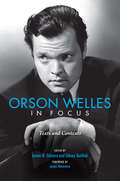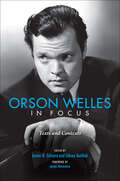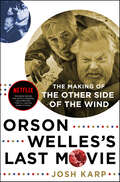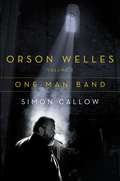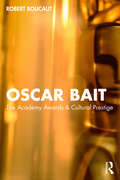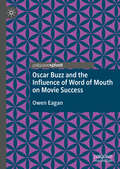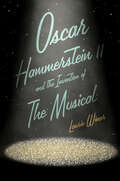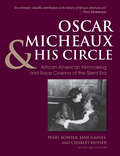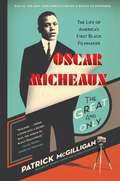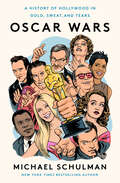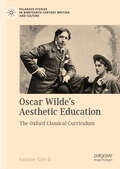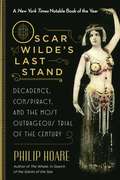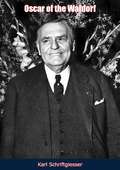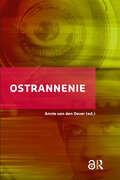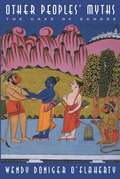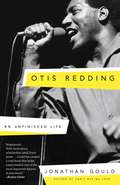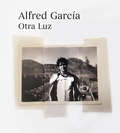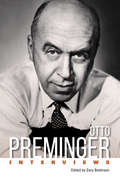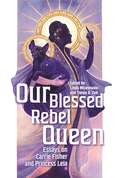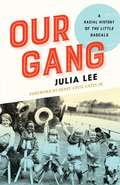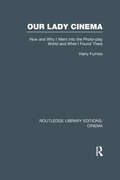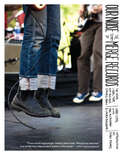- Table View
- List View
Orson Welles in Focus: Texts and Contexts
by James Naremore Sidney Gottlieb James N. GilmoreThrough his radio and film works, such as The War of the Worlds and Citizen Kane, Orson Welles became a household name in the United States. Yet Welles’s multifaceted career went beyond these classic titles and included lesser-known but nonetheless important contributions to television, theater, newspaper columns, and political activism. Orson Welles in Focus: Texts and Contexts examines neglected areas of Welles’s work, shedding light on aspects of his art that have been eclipsed by a narrow focus on his films. By positioning Welles’s work during a critical period of his activity (the mid-1930s through the 1950s) in its larger cultural, political, aesthetic, and industrial contexts, the contributors to this volume examine how he participated in and helped to shape modern media. This exploration of Welles in his totality illuminates and expands our perception of his contributions that continue to resonate today.
Orson Welles in Focus: Texts and Contexts
by James N. Gilmore and Sidney Gottlieb“A wonderful and distinct addition to the Welles canon . . . these pieces explore key elements of Welles’s career, personality, and political beliefs.” —Library JournalThrough his radio and film works, such as The War of the Worlds and Citizen Kane, Orson Welles became a household name in the United States. Yet Welles’s multifaceted career went beyond these classic titles and included lesser-known but nonetheless important contributions to television, theater, newspaper columns, and political activism. Orson Welles in Focus: Texts and Contexts examines neglected areas of Welles’s work, shedding light on aspects of his art that have been eclipsed by a narrow focus on his films. By positioning Welles’s work during a critical period of his activity (the mid-1930s through the 1950s) in its larger cultural, political, aesthetic, and industrial contexts, the contributors to this volume examine how he participated in and helped to shape modern media. This exploration of Welles in his totalityilluminates and expands our perception of his contributions that continue to resonate today.“Anyone who thinks they know Welles will have their eyes opened [by this book].” —Paul Heyer, author of The Medium and the Magician“This is a fascinating collection, several of the contributions making the reader wish for more.” —Film International“A team of scholars has examined the many facets of Orson Welles’ amazing life—theatrical innovator, radio star, celebrated filmmaker, newspaper columnist and progressive activist.” —Wellesnet
Orson Welles's Last Movie: The Making of The Other Side of the Wind
by Josh KarpJournalist Josh Karp shines a spotlight on the making of The Other Side of the Wind—the final unfinished film from the auteur of Citizen Kane in Orson Welles’s Last Movie, the basis of Oscar-winning director Morgan Neville’s Netflix Original Documentary, They’ll Love Me When I’m Dead.In the summer of 1970, legendary but self-destructive director Orson Welles returned to Hollywood from years of self-imposed exile in Europe and decided it was time to make a comeback movie. Coincidentally, it was the story of a legendary self-destructive director who returns to Hollywood from years of self-imposed exile in Europe. Welles swore it wasn’t autobiographical.The Other Side of the Wind was supposed to take place during a single day, and Welles planned to shoot it in eight weeks. It took six years during his lifetime—only to be finally completed more than thirty years after his death by The Last Picture Show director Peter Bogdanovich, who narrates the film, and released by Netflix. Orson Welles’s Last Movie is a fast-paced, behind-the-scenes account of the bizarre, hilarious, and remarkable making of what has been called “the greatest home movie that no one has ever seen.” Funded by the shah of Iran’s brother-in-law, and based on a script that Welles rewrote every night for years, the film was a final attempt to one-up his own best work. It’s a production best encompassed by its star—the celebrated director of The Maltese Falcon, John Huston—who described the making of the film as “an adventure shared by desperate men that finally came to nothing.”
Orson Welles, Volume 3: One-Man Band
by Simon CallowThe third volume of Simon Callow's acclaimed Orson Welles biography, covering the period of his exile from America (1947-1964), when he produced some of his greatest works, including Touch of EvilIn One-Man Band, the third volume in his epic and all-inclusive four-volume survey of Orson Welles's life and work, the celebrated British actor Simon Callow again probes in comprehensive and penetrating detail into one of the most complex, contradictory artists of the twentieth century, whose glorious triumphs (and occasional spectacular failures) in film, radio, theater, and television introduced a radical and original approach that opened up new directions in the arts. This volume begins with Welles's self-exile from America, and his realization that he could function only to his own satisfaction as an independent film maker, a one-man band, in fact, which committed him to a perpetual cycle of money raising. By 1964, he had filmed Othello, which took three years to complete; Mr. Arkadin, the most puzzling film in his output; and a masterpiece in another genre, Touch of Evil, which marked his one return to Hollywood, and like all too many of his films was wrested from his grasp and reedited. Along the way he made inroads into the fledgling medium of television and a number of stage plays, of which his 1955 London Moby-Dick is considered by theater historians to be one of the seminal productions of the century. His private life was as spectacularly complex and dramatic as his professional life. The book reveals what it was like to be around Welles, and, with an intricacy and precision rarely attempted before, what it was like to be him, answering the riddle that has long fascinated film scholars and lovers alike: Whatever happened to Orson Welles?
Oscar Bait: The Academy Awards & Cultural Prestige (Routledge Advances in Film Studies)
by Robert BoucautThe Academy Awards – or "the Oscars" – have held a unique position in defining and enacting "prestige" for film industries and their publics. In evaluating ‘the best’ of film, they wield cultural influence over such cinema practices as consumption and evaluation, filmmaking aesthetics and narratives, and the discursive activity of Hollywood’s industrial agents and audiences. Oscar Bait: The Academy Awards & Cultural Prestige offers a comprehensive insight into how a film or star positions one’s self as a viable competitor worthy of such consecration in new media contexts.Based over three years of ‘Oscars seasons’ (2019–2021), rigorous analysis of film texts, awards telecasts, and circulating discursive media is built through an original scholarly framework for understanding modern cultural awards. Oscar Bait recontextualises the Oscars’ complex legacy into a new media ecosystem, one in which their established value is undercut by declining broadcast viewership, the changing values and demands of global film publics, and influential discourses aiming to progress popular culture beyond its problematic histories. In this new paradigm of film production and consumption, Boucaut explores what the Oscars mean in a contemporary filmmaking landscape and what impacts established stereotypes of Oscar-worthiness – the colloquial ‘Oscar Bait’ – continue to hold over the awards.Oscar Bait captures a dynamic snapshot of the Oscars and Hollywood in a critical era. It advances popular culture scholarship by developing an analytical framework for understanding disparate media texts within an awards season – and it critically updates Oscars knowledges for modern contexts. Readers interested in media and cultural studies, celebrity studies, persona studies, popular culture, and film will enjoy this book.
Oscar Buzz and the Influence of Word of Mouth on Movie Success
by Owen EaganThis book explores why word of mouth is the most important determinant of a movie’s success. Beginning with a discussion of the enduring appeal of movies, and why the box office has survived the disruption of television and will likely survive the disruption of streaming services, Owen Eagan goes on to discuss the unpredictable nature of movies and ways to mitigate their risk. His astute analysis sheds light on the role of film festivals, film critics, Oscar campaigns, and word of mouth in influencing a film's success. Eagan concludes with a summary of why word of mouth is the most influential among all the variables that affect a film’s outcome. Expertly synthesizing quantitative analyses of box office data with illuminating insights from industry experts, this concise and engaging book presents findings with important implications for scholars, industry insiders and marketing professionals alike.
Oscar Hammerstein II and the Invention of the Musical
by Laurie WinerA new look at artist Oscar Hammerstein II as a pivotal and underestimated force in the creation of modern American culture You know his work—Show Boat, Oklahoma!, Carousel, The King and I. But you don’t really know Oscar Hammerstein II, the man who, more than anyone else, invented the American musical. Among the most commercially successful artists of his time, he was a fighter for social justice who constantly prodded his audiences to be better than they were. Diving deep into Hammerstein’s life, examining his papers and his lyrics, critic Laurie Winer shows how he orchestrated a collective reimagining of America, urging it forward with a subtly progressive vision of the relationship between country and city, rich and poor, America and the rest of the world. His rejection of bitterness, his openness to strangers, and his optimistic humor shaped not only the musical but the American dream itself. His vision can continue to be a touchstone to this day.
Oscar Micheaux and His Circle
by Pearl Bowser Jane Gaines Charles MusserOscar Micheaux--the most prolific African American filmmaker to date and a filmmaking giant of the silent period--has finally found his rightful place in film history. Both artist and showman, Micheaux stirred controversy in his time as he confronted issues such as lynching, miscegenation, peonage and white supremacy, passing, and corruption among black clergymen. In this important collection, prominent scholars examine Micheaux's surviving silent films, his fellow producers of race films who alternately challenged or emulated his methods, and the cultural activities that surrounded and sustained these achievements. The relationship between black film and both the stage (particularly the Lafayette Players) and the black press, issues of underdevelopment, and a genealogy of Micheaux scholarship, as well as extensive and more accurate filmographies, give a richly textured portrait of this era. The essays will fascinate the general public as well as scholars in the fields of film studies, cultural studies, and African American history. This thoroughly readable collection is a superb reference work lavishly illustrated with rare photographs.
Oscar Micheaux: The Great and Only
by Patrick McgilliganOscar Micheaux was the Jackie Robinson of film, the black D. W. Griffith: a bigger-than-life American folk hero whose important life story is nearly forgotten today. Now, in a feat of historical investigation and vivid storytelling, one of our greatest film biographers takes on one of the most talented and complex figures in the history of American entertainment. The son of freed slaves, Micheaux grew up in Metropolis, Illinois, then roamed America as a Pullman porter before making his first mark as a homesteader in South Dakota. Disaster and defeat there led him to forge a career publishing a successful series of autobiographical novels. Ever the entrepreneur, when Hollywood failed to bid high enough for film rights to his stories, he answered by forming his own film production company. Going on to produce or direct twenty-two silent and fifteen sound films in his lifetime, Micheaux became the king of the "race cinema" industry at a time when black-produced films had to scrounge for venues in a segregated society. In this groundbreaking new biography, award-winning film historian Patrick McGilligan offers a vivid and fascinating portrait of this little-known pioneer. Part visionary, part raffish Barnum-like showman, Micheaux was both a maverick filmmaker and an inveterate hustler who used every weapon at his disposal to break the color barrier and thrive in a profession he helped to invent. He made a fortune and lost it again, and launched repeated con games that were followed by public arrests and bankruptcies. He eagerly took credit for the work of others-including his unsung-heroine wife. In his desperate later years, he even sunk to plagiarizing his final novel-a discovery McGilligan reveals here for the first time. In this searching exploration, McGilligan tracks down long-lost financial records, unpublished letters, and unmarked pauper's graves, pinpointing Micheaux's birthplace, his tangled personal life, and the circumstances of his tragic death. The result is an epic that bridges a fascinating period in American history, and offers lessons for anyone who would understand the role of black America in forming the culture of our time.
Oscar Wars: A History of Hollywood in Gold, Sweat, and Tears
by Michael SchulmanThe author of the New York Times bestseller Her Again: Becoming Meryl Streep returns with a lively history of the Academy Awards, focusing on the brutal battles, the starry rivalries, and the colorful behind-the-scenes drama.America does not have royalty. It has the Academy Awards. For nine decades, perfectly coiffed starlets, debonair leading men, and producers with gold in their eyes have chased the elusive Oscar. What began as an industry banquet in 1929 has now exploded into a hallowed ceremony, complete with red carpets, envelopes, and little gold men. But don’t be fooled by the pomp: the Oscars, more than anything, are a battlefield, where the history of Hollywood—and of America itself—unfolds in dramas large and small. The road to the Oscars may be golden, but it’s paved in blood, sweat, and broken hearts.In Oscar Wars, Michael Schulman chronicles the remarkable, sprawling history of the Academy Awards and the personal dramas—some iconic, others never-before-revealed—that have played out on the stage and off camera. Unlike other books on the subject, each chapter takes a deep dive into a particular year, conflict, or even category that tells a larger story of cultural change, from Louis B. Mayer to Moonlight. Schulman examines how the red carpet runs through contested turf, and the victors aren't always as clear as the names drawn from envelopes. Caught in the crossfire are people: their thwarted ambitions, their artistic epiphanies, their messy collaborations, their dreams fulfilled or dashed.Featuring a star-studded cast of some of the most powerful Hollywood players of today and yesterday, as well as outsiders who stormed the palace gates, this captivating history is a collection of revelatory tales, each representing a turning point for the Academy, for the movies, or for the culture at large.
Oscar Wilde's Aesthetic Education: The Oxford Classical Curriculum (Palgrave Studies in Nineteenth-Century Writing and Culture)
by Leanne GrechThis book focuses on the role that the Oxford classical curriculum has had in shaping Oscar Wilde’s aestheticism. It positions Wilde as a classically trained intellectual and outlines the path he took to gain recognition as a writer and promoter of the aesthetic movement. This narrative is conveyed through a broad range of literary sources, including Wilde’s travel poetry, American lectures, and canonical works like ‘The Critic as Artist’, The Soul of Man, The Picture of Dorian Gray and De Profundis. This study proposes that Wilde approached aestheticism as a personalised, self-directed learning experience – a mode of self-culture – which could be used to maintain an intellectual life outside of the university. It also explores Wilde’s thoughts on education and considers the significance of male friendship at Oxford, and in Wilde’s life and literature.
Oscar Wilde's Last Stand: Decadence, Conspiracy, and the Most Outrageous Trial of the Century
by Philip HoareA New York Times Notable Book of the Year that Sir Ian McKellen called "a shocking tale of heroes and villains-illuminating and upsetting in equal measure.”The first production of Oscar Wilde’s Salomé in 1918, with American exotic dancer Maud Allan dancing lead, ignited a firestorm in London spearheaded by Noel Pemberton Billing, a member of Parliament and self-appointed guardian of family values. Billing attacked Allan in the right-wing newspaper Vigilante as a member of the "Cult of the Clitoris,” a feminine version of the "Cult of the Wilde,” a catchall for the degeneracy and perversion he was convinced had infected the land. He claimed that a black book was in the hands of their enemies the Germans, a book that contained the names of thousands of the British establishment who without doubt were members of the cult. Threat of exposure was costing England the war.Allan sued Billing for libel, and the ensuing trial, brought to life in this authoritative, spellbinding book, held the world in thrall. Was there or was there not a black book? What names did it contain? The trial was both hugely entertaining and deadly serious and raised specters of hysteria, homophobia, and paranoia that, like Oscar Wilde himself, continue to haunt us. As in Wilde’s own trial in 1895, libel was hardly the issue; the fight was for control over the country’s moral compass. In Oscar Wilde’s Last Stand, biographer and historian Philip Hoare gives us the full drama of the Billing trial, gavel to gavel, and brings to life this unique, bizarre, and fascinating event.Skyhorse Publishing, as well as our Arcade imprint, are proud to publish a broad range of books for readers interested in history--books about World War II, the Third Reich, Hitler and his henchmen, the JFK assassination, conspiracies, the American Civil War, the American Revolution, gladiators, Vikings, ancient Rome, medieval times, the old West, and much more. While not every title we publish becomes a New York Times bestseller or a national bestseller, we are committed to books on subjects that are sometimes overlooked and to authors whose work might not otherwise find a home.
Oscar of the Waldorf
by Karl SchriftgiesserThe present volume is the biography of Oscar Tschirky (1866-1943), known throughout the world as Oscar of the Waldorf, who worked as maître d’hôtel of the Waldorf Astoria Hotel in New York City from 1893 to 1943. The book contains many recollections devoted to the Waldorf Astoria Hotel and its founder, George C. Boldt, and his wife, Louise Kehrer Boldt.Richly illustrated throughout with black and white photographs.
Ostalgie in German Cinema After Reunification
by Tatiana AstafevaThis book provides a thorough overview of the ostalgie films about the German Democratic Republic (GDR) produced since the 1990s. Far from being a homogenous phenomenon that romanticizes the totalitarian state, the ostalgie genre is multifaceted, reflexive, and at times subversive. Thus, Astafeva argues, the core of "ostalgie" is an experience of distance that is ‘prefocused’ by various aesthetic strategies. This genre-based definition makes it possible to conceptualize the phenomenon of ostalgie film in its heterogeneity and to reveal the mechanisms that lay in the essence of ostalgic experience. The cognitivist-phenomenological approach is underpinned by historiographic and genre theory and close analysis of film examples—from the most popular ostalgie films such as Goodbye, Lenin! (Wolfgang Becker, 2003) to lesser-known film productions and recent series such as Kleo (2022–2024)—that allow exploration of various functions of the ostalgic experience. Ostalgie films can foster uncritical reactionary and conservative views of history and expose the experience of distance by orienting aesthetics toward kitsch and retro. They can also encourage reflexive and meta-reflexive understandings of history so that the GDR past is critically discussed and reworked. Furthermore, ostalgie films can in some cases activate historical consciousness, facilitate the production of historical knowledge, and generate ethical thinking and empathy.
Ostrannenie: On "Strangeness" and the Moving Image. The History, Reception, and Relevance of a Concept (The Key Debates: Mutations and Appropriations in European Film Studies)
by Annie van den OeverOstrannenie (‘making it strange’) has become one of the central concepts of modern artistic practice, ranging over movements including Dada, postmodernism, epic theatre, and science fiction, as well as our response to arts. Coined by the ‘Russian Formalist’ Viktor Shklovsky in 1917, ostrannenie has come to resonate deeply in Film Studies, where it entered into dialogue with the Brechtian concept of Verfremdung, the Freudian concept of the uncanny and Derrida's concept of différance. Striking, provocative and incisive, the essays of the distinguished film scholars in this volume recall the range and depth of a concept that since 1917 changed the trajectory of theoretical inquiry.
Otis Redding: An Unfinished Life
by Jonathan GouldThe long-awaited, definitive biography of The King of Soul, timed to coincide with the 50th anniversary of Redding's iconic performance at the 1967 Monterey Pop Festival. Otis Redding remains an immortal presence in the canon of American music on the strength of such classic hits as “(Sittin’ on) The Dock of the Bay,” “I’ve Been Loving You Too Long,” “Try a Little Tenderness,” and “Respect,” a song he wrote and recorded before Aretha Franklin made it her own. As the architect of the distinctly southern, gospel-inflected style of rhythm & blues associated with Stax Records in Memphis, Redding made music that has long served as the gold standard of 1960s soul. Yet an aura of myth and mystery has always surrounded his life, which was tragically cut short at the height of his career by a plane crash in December 1967. In Otis Redding: An Unfinished Life, Jonathan Gould finally does justice to Redding’s incomparable musical artistry, drawing on exhaustive research, the cooperation of the Redding family, and previously unavailable sources of information to present the first comprehensive portrait of the singer’s background, his upbringing, and his professional career. In chronicling the story of Redding’s life and music, Gould also presents a social history of the time and place from which they emerged. His book never lets us forget that the boundaries between black and white in popular music were becoming porous during the years when racial tensions were reaching a height throughout the United States. His indelible portrait of Redding and the mass acceptance of soul music in the 1960s is both a revealing look at a brilliant artist and a provocative exploration of the tangled history of race and music in America that resonates strongly with the present day.
Otra Luz
by Alfred GarcíaEste conjunto de poemas, canciones y fotografías de Alfred García son el cuaderno de bitácora de su última gira y de algunas impresiones que tuvo a partir de su participación en Operación Triunfo, Eurovisión y de la creación de su disco 1016. Sus textos e instantáneas nos permiten conocer su mundo íntimamente. «Los que le conocéis y cantáis sus temas en los conciertos, que no para de ofrecer en esta gira interminable, sabéis de lo que hablo. Muchos días actúa por convicción, pero, como buen músico de jazz, sabe que la improvisación lo es todo en la vida, más para un individuo tan intuitivo como él.»David Castillo, periodista, escritor y biógrafo de Dylan
Otto Preminger: Interviews (Conversations with Filmmakers Series)
by Gary BettinsonOtto Preminger (1905–1986), whose Hollywood career spanned the 1930s through the 1970s, is popularly remembered for the acclaimed films he directed, among which are the classic film noir Laura, the social-realist melodrama The Man with the Golden Arm, the CinemaScope musical Carmen Jones, and the riveting courtroom drama Anatomy of a Murder. As a screen actor, he forged an indelible impression as a sadistic Nazi in Billy Wilder’s Stalag 17 and as the diabolical Mr. Freeze in television’s Batman. He is remembered, too, for drastically transforming Hollywood’s industrial practices. With Exodus, Preminger broke the Hollywood blacklist, controversially granting screen credit to Dalton Trumbo, one of the exiled “Hollywood Ten.” Preminger, a committed liberal, consistently shattered Hollywood’s conventions. He routinely tackled socially progressive yet risqué subject matter, pressing the Production Code’s limits of permissibility. He mounted Black-cast musicals at a period of intense racial unrest. And he embraced a string of other taboo topics—heroin addiction, rape, incest, homosexuality—that established his reputation as a trailblazer of adult-centered storytelling, an enemy of Hollywood puritanism, and a crusader against censorship. Otto Preminger: Interviews compiles nineteen interviews from across Preminger’s career, providing fascinating insights into the methods and mindset of a wildly polarizing filmmaker. With remarkable candor, Preminger discusses his filmmaking practices, his distinctive film style, his battles against censorship and the Hollywood blacklist, his clashes with film critics, and his turbulent relationships with a host of well-known stars, from Marilyn Monroe and Frank Sinatra to Jane Fonda and John Wayne.
Our Blessed Rebel Queen: Essays on Carrie Fisher and Princess Leia (Contemporary Approaches to Film and Media Series)
by Linda Mizejewski Ken Feil Kristen Anderson Wagner Jennifer M. Fogel Cynthia A. Hoffner Maghan Molloy Jackson Philipp Dominik Keidl Andrew Kemp-Wilcox Slade Kinnecott Sejung Park Tanya D. ZukOur Blessed Rebel Queen: Essays on Carrie Fisher and Princess Leia is the first full-length exploration of Carrie Fisher’s career as actress, writer, and advocate. Fisher’s entangled relationship with the iconic Princess Leia is a focal point of this volume. Editors Linda Mizejewski and Tanya D. Zuk have assembled a collection that engages with the multiple interfaces between Fisher’s most famous character and her other life-giving work. The contributors offer insights into Fisher as science-fiction idol, author, feminist inspiration, and Lucasfilm commodity. Jennifer M. Fogel examines the thorny "ownership" of Fisher’s image as a conflation of fan nostalgia, merchandise commodity, and eventually, feminist icon. Philipp Dominik Keidl looks at how Carrie Fisher and her iconic character are positioned within the male-centric history of Star Wars. Andrew Kemp-Wilcox researches the 2016 controversy over a virtual Princess Leia that emerged after Carrie Fisher’s death. Tanya D. Zuk investigates the use of Princess Leia and Carrie images during the Women’s March as memetic reconfigurations of historical propaganda to leverage political and fannish ideological positions. Linda Mizejewski explores Carrie Fisher’s autobiographical writing, while Ken Feil takes a look at Fisher’s playful blurring of truth and fiction in her screenplays. Kristen Anderson Wagner identifies Fisher’s use of humor and anger to challenge public expectations for older actresses. Cynthia Hoffner and Sejung Park highlight Fisher’s mental health advocacy, and Slade Kinnecott personalizes how Fisher’s candidness and guidance about mental health were especially cherished by those who lacked a support system in their own lives. Our Blessed Rebel Queen is distinct in its interdisciplinary approach, drawing from a variety of methodologies and theoretical frameworks. Longtime fans of Carrie Fisher and her body of work will welcome this smart and thoughtful tribute to a multimedia legend.
Our Gang: A Racial History of The Little Rascals
by Julia LeeIt was the age of Jim Crow, riddled with racial violence and unrest. But in the world of Our Gang, black and white children happily played and made mischief together. They even had their own black and white version of the KKK, the Cluck Cluck Klams—and the public loved it. The story of race and Our Gang, or The Little Rascals, is rife with the contradictions and aspirations of the sharply conflicted, changing American society that was its theater. Exposing these connections for the first time, Julia Lee shows us how much this series, from the first silent shorts in 1922 to its television revival in the 1950s, reveals about black and white American culture—on either side of the silver screen. Behind the scenes, we find unconventional men like Hal Roach and his gag writers, whose Rascals tapped into powerful American myths about race and childhood. We meet the four black stars of the series—Ernie &“Sunshine Sammy&” Morrison, Allen &“Farina&” Hoskins, Matthew &“Stymie&” Beard, and Billie &“Buckwheat&” Thomas—the gang within the Gang, whose personal histories Lee pursues through the passing years and shifting political landscape. In their checkered lives, and in the tumultuous life of the series, we discover an unexplored story of America, the messy, multiracial nation that found in Our Gang a comic avatar, a slapstick version of democracy itself.
Our Journey: Rak Su’s Official Autobiography. The X Factor Winners
by Rak-SuA shout-out to all fans of Rak-Su - this is their story, from where it all began to where they are now, full of exclusive stories and pictures. Make it a special day. Make it a Rak-Su day! __________Rak-Pack! Are you ready for our official story?As long as we've been friends, we've been creating our unique sound of soul, R'n'B, Hip-Hop, Latin and Caribbean music.Keeping the momentum going from our X-Factor journey, we are now performing at sold-out arenas, making more music and having fun!So why not join us on the adventure? Unrivalled access to never-before-seen photos, intimate stories, and behind-the-scenes info - in our first and only memoir!_________Ashley, Jamaal, Myles and Mustafa shot to stardom in 2017 as the first ever male group to win the X-Factor. Since then, the soulful boys have been topping the charts with their eclectic sound, performing at sold-out arenas, touring with global sensation Little Mix, recording their first album and most recently dropping their brand new hit single, Pyro Ting.Join Rak-Su on their journey from ordinary North-West London lads, to victors of one of the world's biggest talent shows in their one and ONLY! OFFICIAL memoir, Our Journey.
Our Kind of Movie: The Films of Andy Warhol
by Douglas CrimpA celebrated writer on contemporary art and queer culture argues that Andy Warhol's films enable us to see differently, and to see a different world.“We didn't think of our movies as underground or commercial or art or porn; they were a little of all of those, but ultimately they were just 'our kind of movie.'”—Andy WarholAndy Warhol was a remarkably prolific filmmaker, creating more than 100 movies and nearly 500 of the film portraits known as Screen Tests. And yet relatively little has been written about this body of work. Warhol withdrew his films from circulation in the early 1970s and it was only after his death in 1987 that they began to be restored and shown again. With Our Kind of Movie Douglas Crimp offers the first single-authored book about the full range of Andy Warhol's films in forty years—and the first since the films were put back into circulation.In six essays, Crimp examines individual films, including Blow Job, Screen Test No. 2, and Warhol's cinematic masterpiece The Chelsea Girls (perhaps the most commercially successful avant-garde film of all time), as well as groups of films related thematically or otherwise—films of seductions in confined places, films with scenarios by Ridiculous Theater playwright Ronald Tavel. Crimp argues that Warhol's films make visible new, queer forms of sociality. Crimp does not view these films as cinéma-vérité documents of Warhol's milieu, or as camera-abetted voyeurism, but rather as exemplifying Warhol's inventive cinema techniques, his collaborative working methods, and his superstars' unique capabilities. Thus, if Warhol makes visible new social relations, Crimp writes, that visibility is inextricable from his making a new kind of cinema.In Our Kind of Movie Crimp shows how Warhol's films allow us to see against the grain—to see differently and to see a different world, a world of difference.
Our Lady Cinema: How and Why I went into the Photo-play World and What I Found There (Routledge Library Editions: Cinema)
by Harry FurnissThis charming classic of film literature was originally published in 1914 and hence represents an early attempt to catalogue the allure of cinema and how the motion picture industry began. This tale of life in the early days of cinema will be of interest to film historians and anyone interested in that period of history. The book outlines the actors, the producers, the studios and the audiences as well as the advertising and regulation at the time with often amusing stories and facts along with the author’s own drawings. Overall this serves as a fascinating introduction to the making of early films, which at the time was a great mystery to most people.
Our Noise: The Story of Merge Records, the Indie Label That Got Big and Stayed Small
by John Cook Laura Ballance Mac McCaughanMerge Records defies everything you’ve heard about the music business. Started by two twenty-year-old musicians, Merge is a lesson in how to make and market great music on a human scale. The fact that the company is prospering in a failing industry is something of a miracle. Yet two of their bands made the Billboard Top 10 list; more than 1 million copies of Arcade Fire's Neon Bible have been sold; Spoon has appeared on Saturday Night Live and The Tonight Show; and the Magnetic Fields' 69 Love Songs is a contemporary classic. In celebration of their twentieth anniversary, founders Mac and Laura offer first-person accounts—with the help of their colleagues and Merge artists—of their work, their lives, and the culture of making music. Our Noise also tells the behind-the-scenes stories of Arcade Fire, Spoon, the Magnetic Fields, Superchunk, Lambchop, Neutral Milk Hotel, and Butterglory. Hundreds of personal photos of the bands, along with album cover art, concert posters, and other memorabilia are included.
